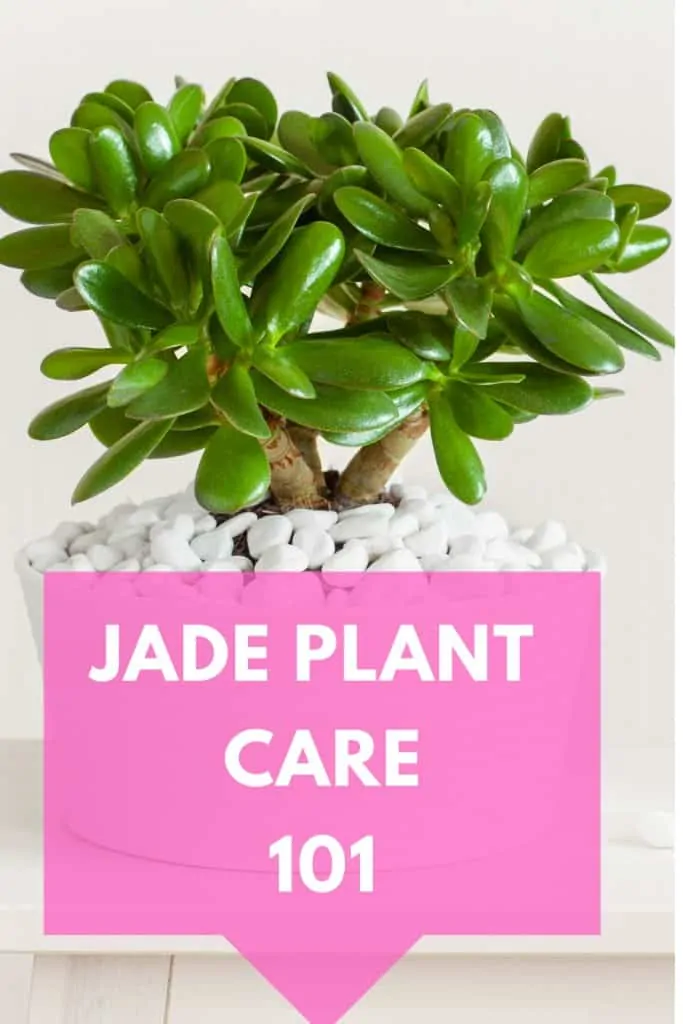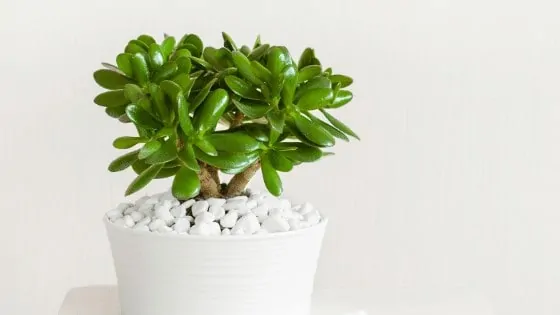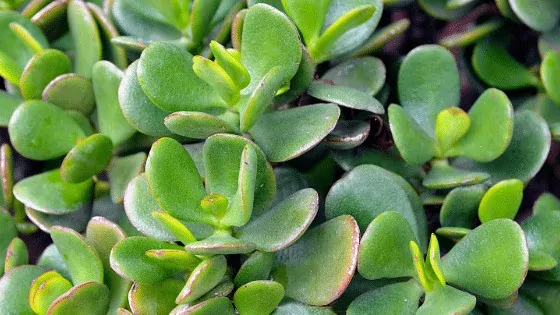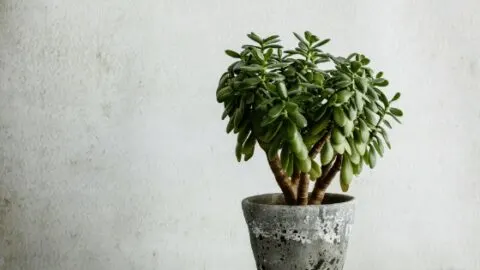The jade plant, or the Crassula ovata, is a favorite houseplant among beginners and advanced plant enthusiasts. And for a good reason.
Jade plants are often called the “lucky plant” or the “money plant”. These plants originate from Mozambique and South Africa but they can grow anywhere.
Since they’re succulents, jade plant care is easier than the care for most houseplants. They’re perfect for newbies and anyone with a busy life.
Jade Plant Care Summary
| Species | Crassula ovata |
|---|---|
| Synonyms | Jade plant, Money plant, Friendship tree |
| Family | Crassulaceae |
| Genus | Crassula |
| Growth | Compact, bushy |
| Height | 3ft / 0.9m |
| Width | 2ft / 0.6m |
| Soil | Well-draining |
| Watering | Every 7-14 days |
| Light | Bright indirect |
| Temperature | 65 – 85°F / 18.3 – 29.4°C |
| Humidity | 30 – 60% |
| Fertilizer | Once a month |
| Propagation | Stem cuttings, leaf cuttings |
| Toxicity | Toxic to humans and animals |
Table of Contents

Succulent plants retain water, even in the hottest of climates. They can store water in their stem or leaves.
This creates a plant that’s easier to care for since you don’t have to water them as much.
Plus, their unique aesthetic attracts all sorts of plant lovers over the globe.
Are you curious about the jade plant? Do you already have one and don’t know what to do?
We have everything you need to know about jade plant care in this guide!
Jade Plant Care Guide

Soil
The average potting soil could kill your jade plant. Since jade plants absorb and keep water, it’s easy to over-water them.
Most potting soils retain water so it goes to the root when it starts to dry.
This leads to a condition called “wet feet”, which we’ll discuss more down below.
When you’re shopping for potting soil, check out soil made for succulent plants or cacti.
Light
Light is essential for the right jade plant care. You should place your jade plant in either a south or west-facing window. Indirect light is what’s going to help your plant grow above and beyond.
They still need lots of light to thrive. Not enough light results in a weak plant that refuses to grow.
But too much direct light can burn their leaves, leaving ugly and unhealthy brown spots. It can also dehydrate the plant until it dies.
You can use artificial lights for jade plant care instead of natural light. If you don’t have access to enough sunlight, try grow lights as a substitute.
To make sure you activate photosynthesis, the grow lights need to emit at least 2,000 lumens per square foot.
They need to be on for about 12 hours and in darkness for 12 hours.
You should place the plants about six inches away so they’re not getting hit with too much light.
Read our extensive article about the right light level for plants.
Watering
When jade plants die, overwatering often plays an essential role in the wrong jade plant care according to the Clemson Home & Garden information center.
As we stated earlier, jade plants can soak up water in their stems and leaves. They keep the water to water themselves as they need it.
So, you only need to water it when the soil has turned dry. This takes about a week or two.
Always use filtered or distilled water. Jade plants don’t mix well with the salt in tap water.
Beware of getting water on the leaves while watering. It’s a soil only situation. Otherwise, it can lead to your plant rotting away.
You can also read our extensive guide dedicated to how to water succulents the right way!
Temperature
Jade plants thrive during the day between the temperatures of 65F-75F (18°C – 24°C). At night, the temperature should be between 50F-55F (10°C – 13°C).
Anything under 50F will damage the plant or even kill it. So make sure that your temperature levels stay in the right range for the right jade plant care.
Humidity
Jade plants hate too much humidity. Too much moisture in the air creates too much moisture for the plant.
Low humidity is best. They survive well in dry air. The humidity in the room should be about 35% to 50%.
What we can take away from this section is that proper jade plant care requires rather low humidity.
Fertilizer
Like with watering, you don’t have to feed a jade all the time as this is not the most important topic regarding jade plant care. There is fertilizer made for succulent plants and they’re usually water-soluble.
From April to October, you fertilize the plant every two weeks.
From November to March when your plant isn’t growing as much, only fertilize it every two or three months.
When you use water fertilizer, you have to water the plant right before and right after. Since it’s water-soluble, it needs to dissolve in the water to feed the plant.
You don’t want too much fertilizer to build up in the soil. You have to flush the soil once in April and once in November.
Propagation
When it comes to propagating jade plants, you can use either stem or leaves. Keep reading for the detailed steps to propagate your plant.
Growth
Some jade plants can grow up to five feet tall. That’s the great part about jade plant care. These plants can grow into sizeable trees if your jade plant care follows our best practices. Make sure you have the room before you take one on.
The leaves of the plant can grow up three to nine centimetres long. They grow to two to four centimetres in width.
Potting
You should re-pot a jade plant after a year or two. When the branches feel too heavy, it’s time to move to a bigger pot.
Don’t go too much bigger than the pot it’s already in. Otherwise, you’re putting the roots of the plant into shock.
The roots aren’t able to root through the soil causing stress on the plant.
Jade Plant Propagation Steps
Jade plants are easy to propagate and as soon as you know it, you have multiple plants that you can apply your jade plant care to.
The best time of the year to propagate a jade plant is during the warmer months.
Stem cuttings are the speediest option for jade plant propagation. Leaves take longer but they still grow a strong jade plant if the process is done right.
Using Stem Cuttings
- First, you have to get your stem cut. Whenever you’re pruning, take the time to cut a piece of the stem. Cut a piece that’s two inches to four inches, so it’s long enough to take root. And cut right above a leaf node. If it’s possible, the stem cutting should have two leaves still attached.
- Lay your stem cutting out for about a week in a warm area of your home. You’re curing the stem cutting. This allows a callous to form over the end that you cut. The callous encourages rooting. Even better, it stops it from rotting later on.
- Self-draining pots are a great choice for jade plants. Fill up your pot with succulent-friendly soil. You want moist soil before you plant. Wait for the extra water to drain before moving on to the next step.
- Now, use your finger to make a small hole in the middle of the soil. Place your stem cutting into the hole.
- You want the cutting to stand straight up. If it can’t support itself, you can tie it to a straw to hold it up.
- Let it sit in indirect but bright sunlight so it can take root and grow.
Using Leaf Cuttings

- leaf off of the jade plant but make sure you get the whole stem of the leaf. And make sure the leaf is healthy.
- hormones speed up the rooting from the leaf. Dust the leaf with the rooting hormone. Do this not long after you cut the leaf so the hormones can spread throughout the leaf. Let it sit out so it dries out a bit but don’t leave it out for too long.
- soil but don’t overdo it. Like before, let the excess water drain from the pot before heading on to the next step.
- Lay the leaf on the soil while covering the stem of the leaf with the soil.
- it’s a long process when you use a leaf to propagate.
Varieties of the Jade Plant
There are tons of different jade plants out there. We’re going to share our favourite jade plants. Jade plant care is not only fun and easy, but there is also a lot of variety.

Crassula Ovata Botany Bay
The Botany Bay is an easy jade plant to propagate. It’s great for beginners but amateurs love it too as the jade plant care for this one is easy. In winter, small pink flowers bloom on the plant.
Crassula Ovata Harbour Lights
The Harbor Lights jade plant is newer. During the fall, they start as small pink pretty flowers. They also have red foliage that pops up in the winter months.
Crassula Ovata Hobbit
This is a tiny jade plant that’s perfect to grow for gifts. They’re called hobbits for a reason! Like many other jade plants, they bloom pink flowers in the cold months.
Crassula Ovata Little Jade Tree
Little Jade Trees are adorable plants. They have a bonsai tree feel and look to them. A downside to this small plant is that flowering isn’t consistent.
Crassula Ovata Pink
These are beautiful plants. Once the cold months hit, the pink flowers bloom on the plant. They pop up above the foliage and stand out in any room.
Crassula Ovata Ruby
The Ruby is an underrated plant. They’re small with their ruby red blushed leaves. But appear fuller once the flowers bloom. The flowers come out to play with clusters of both white and pink flowers.
Crassula Ovata Sienna
Sienna clusters together for a full looking plant. During fall and winter, the flowers bloom with love. These flowers are clusters of both pink and white.
Portulacaria Variegata
This jade plant grows slow but it’s worth the wait. The leaves are a pretty off-white colour and the branches are a unique red. They fit into any modern home.
Common Problems you may encounter regarding the Jade Plant Care
“Wet feet” is a huge problem with jade plants. You have to be careful not to over-water them.
Wet feet happens when the soil is too saturated with water. Oxygen can’t get through the soil to the roots of the plant.
As you know, your plant depends on oxygen as much as you do. So, no oxygen to the roots will kill it.
Since these plants retain water, it’s pretty easy to over-water if you’re not careful.
Which is why it’s important to make sure the soil is dry before you do water your plant.
Mealybugs are the biggest pest problem with jade plants. They hide under leaves and they eat the leaves away.
They start as waxy looking sacs until they hatch into these pests.
To get rid of mealybugs, wipe them off the leaves with a cotton ball. The cotton ball should have rubbing alcohol but don’t douse it in the stuff.
You’ll have to repeat the process when the eggs left behind hatch.
Pests and root rot are the least fun topics regarding jade plant care. We hope these tips and tricks help you to not only spot problems early on but to also help you find the right remedy.
Tips for an Unhappy Jade Plant
Is your jade plant looking unhealthy and unhappy? Below are the most common issues with jade plants and how to adjust your jade plant care.
Your Jade Plant is Losing Leaves
We all panic when we see our plant losing leaves. It’s the first sign of an unhealthy plant.
When a jade plant is losing leaves, the plant isn’t getting enough light. Try setting it on a south-facing window sill or adjust your grow lights.
If the leaves falling off are older, the plant is getting too much heat. Move the plant into a cooler room.
Your Jade Plant is Turning Yellow
It’s a common problem for a jade plant’s leaves to turn yellow. This is due to over-watering and you need to adjust your jade plant care.
Check the roots. Rotted roots mean your plant can’t be saved. But if they’re healthy, you’re still good.
To remedy the situation, move the plant into a new pot with new soil. Make sure you watch the water level of the soil this time around.
FAQ
Are jade plants a form of cacti?
No, jade plants aren’t a type of cacti. But they’re related since they both belong to the succulent group.
Why are there small white spots on my jade plant?
In most cases, this is excess salt comes through the leaves of the plant. You can take a damp paper towel and wipe the salt off the leaves. This is quite common to see in jade plant care.
Why is it taking forever for my jade plant to flower?
Your jade plant is getting too much light. Make sure it’s getting enough dark time.
They flower in the winter months so they must get 12 hours of darkness during the winter months.
How do I make my jade plant thicker?
If your jade plant is too thin, pruning can address the problem. Don’t over-prune but don’t be shy about it either. It’s important to prune above the leaf scars.

Daniel has been a plant enthusiast for over 20 years. He owns hundreds of houseplants and prepares for the chili growing seasons yearly with great anticipation. His favorite plants are plant species in the Araceae family, such as Monstera, Philodendron, and Anthurium. He also loves gardening and is growing hot peppers, tomatoes, and many more vegetables.


